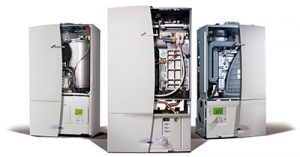
In the early times of the 1st century AD, boilers were already present thanks to Hero of Alexandria – although it was first made as a toy and not for central heating. It was only a lot after the 1st century – during the 17th century – that it was seen in another light where its potential on practical work with steam power was noticed. It was in 1679 when Denis Papin of France who premeditated the first boiler which had safety valves. Afterward, the start of the production of boilers was opened in England in the 18th century. The first boilers were made of formed iron. Later on, the realization sunk in when pressure and temperature were important variables in the efficiency of boilers and iron wasn’t quite cut out for that making manufacturers switch to using steel instead. Boilers nowadays are now manufactured using alloy steel to ensure high-quality boilers that can deliver and tolerate high temperatures and pressures.
Boilers are a type of central heating system which utilizes the heating of water or steam to create and disperse heat into the interior of the home. It fires up gas, oil, electricity or coal to function. It consists of tubes, pipes, and ducts where water can move through for the delivery of heated steam or water throughout the space. The steam it gives off can have different uses such as sterilization, running of production equipment, but most importantly it is commonly used to give off warmth into the interior of the home, office and many more.
Boiler, also called Steam Generator, apparatus designed to convert a liquid to vapour. In a conventional steam power plant, a boiler consists of a furnace in which fuel is burned, surfaces to transmit heat from the combustion products to the water, and a space where steam can form and collect. A conventional boiler has a furnace that burns a fossil fuel or, in some installations, waste fuels. A nuclear reactor can also serve as a source of heat for generating steam under pressure.
Most conventional steam boilers are classed as either fire-tube or watertube types. In the fire-tube type, the water surrounds the steel tubes through which hot gases from the furnace flow. The steam generated collects above the water level in a cylindrically shaped drum.
Full article at Britannica.
Boiler heating systems produce energy by heating water and giving off heat with the help of a radiator. This heating system makes use either of water or steam which is transferred into pipes then distributed around the interior of the house. There is a cycle when using boilers where after it completes dispersing heat into the radiators it is then rerouted back for reheating for future use.
Boilers create a cleaner dispersion of air compared to other heating systems since this type of heating does not create dust particles and possible allergens, this is so because it does not use new air like other forced air systems do which causes the upbringing of dust particles and allergens. Boilers also provide high-quality heat, it disperses cleaner, fresher, and more evenly spread heat into the space due to the fact that it is from a radiator whereas forced air systems use vents and ductwork which uses up more energy. Boilers are also capable of adjusting the heat, depending on how warm you want the temperature to be. Another benefit you can have from boilers is that it creates no noise amongst most of the system – the only noise it creates is operational noise in the boiler – compared to other heating systems that create a lot of noise as air is ventilated in.
The ErP Rating is a new requirement set by the European Union which is designed to drive improvements in the efficiency and performance of heating and hot water products. The ErP rating introduces new efficiency classes from A++ to G which are displayed on a labels which come with the boiler. ErP labels are already a common sight on washing machines, televisions and other appliances within electrical retailers.
Deciding which boiler will make an efficient and practical fit with your home and lifestyle can be confusing. The images below show the main system types, how they work, their advantages and what kind of homes they work best in. If your new boiler is going to be fitted onto your existing system, please consider the cleanliness of your existing pipework and radiators as this could cause damage to your new boiler.
Boilers have long been with us and have always helped create a warmer ambiance according to our liking. It uses water to create heated water or steam to deliver heat into the house via radiators. The water is then recycled and reused for continuous or later heating. This creates a cleaner atmosphere, a much less noisier and an efficient way of heating the home.
Boilers are a great medium for creating warmth into the interior of your home, but it depends on how it matches your demands, your home, and your budget. The market provides many options for you to choose the best and most suitable heating system for you, with the help of technology you can now see how the efficacy of boilers are when it comes to heating up your home.
To learn more about how boilers work, check this video out:
Other Resources:
How to Choose the Perfect Air Conditioning Unit for Your Home
Air Conditioner Maintenance Tips
Simple Tips to Stop a Leak While Waiting for an Emergency Plumber